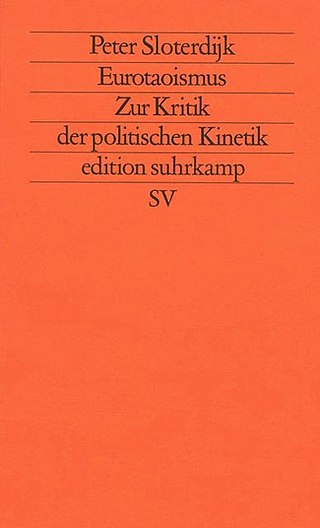Related Research Articles

The Cenozoic Era is Earth's current geological era, representing the last 66 million years of Earth's history. It is characterized by the dominance of mammals, insects, birds and angiosperms. It is the latest of three geological eras of the Phanerozoic Eon, preceded by the Mesozoic and Paleozoic. The Cenozoic started with the Cretaceous–Paleogene extinction event, when many species, including the non-avian dinosaurs, became extinct in an event attributed by most experts to the impact of a large asteroid or other celestial body, the Chicxulub impactor.

The Holocene is the current geological epoch, beginning approximately 11,700 years ago. It follows the Last Glacial Period, which concluded with the Holocene glacial retreat. The Holocene and the preceding Pleistocene together form the Quaternary period. The Holocene is an interglacial period within the ongoing glacial cycles of the Quaternary, and is equivalent to Marine Isotope Stage 1.

Apes are a clade of Old World simians native to sub-Saharan Africa and Southeast Asia. Apes are more closely related to Old World monkeys than to the New World monkeys (Platyrrhini) with both Old World monkeys and apes placed in the clade Catarrhini. Apes do not have tails due to a mutation of the TBXT gene. In traditional and non-scientific use, the term ape can include tailless primates taxonomically considered Cercopithecidae, and is thus not equivalent to the scientific taxon Hominoidea. There are two extant branches of the superfamily Hominoidea: the gibbons, or lesser apes; and the hominids, or great apes.

The macaques constitute a genus (Macaca) of gregarious Old World monkeys of the subfamily Cercopithecinae. The 23 species of macaques inhabit ranges throughout Asia, North Africa, and Europe. Macaques are principally frugivorous, although their diet also includes seeds, leaves, flowers, and tree bark. Some species such as the long-tailed macaque will supplement their diets with small amounts of meat from shellfish, insects, and small mammals. On average, a southern pig-tailed macaque in Malaysia eats about 70 large rats each year. All macaque social groups are arranged around dominant matriarchs.

The Anthropocene is a now rejected proposal for the name of a geological epoch that would follow the Holocene, dating from the commencement of significant human impact on Earth up to the present day. It was rejected in 2024 by the International Commission on Stratigraphy in terms of being a defined geologic period. The impacts of humans affect Earth's oceans, geology, geomorphology, landscape, limnology, hydrology, ecosystems and climate. The effects of human activities on Earth can be seen for example in biodiversity loss and climate change. Various start dates for the Anthropocene have been proposed, ranging from the beginning of the Neolithic Revolution, to as recently as the 1960s. The biologist Eugene F. Stoermer is credited with first coining and using the term anthropocene informally in the 1980s; Paul J. Crutzen re-invented and popularized the term. However, in 2024 the International Commission on Stratigraphy (ICS) and the International Union of Geological Sciences (IUGS) rejected the Anthropocene Epoch proposal for inclusion in the Geologic Time Scale.

The rhesus macaque, colloquially rhesus monkey, is a species of Old World monkey. There are between six and nine recognised subspecies split between two groups, the Chinese-derived and the Indian-derived. Generally brown or grey in colour, it is 47–53 cm (19–21 in) in length with a 20.7–22.9 cm (8.1–9.0 in) tail and weighs 5.3–7.7 kg (12–17 lb). It is native to South, Central, and Southeast Asia and has the widest geographic range of all non-human primates, occupying a great diversity of altitudes and habitats.

Dipesh Chakrabarty is an Indian historian and leading scholar of postcolonial theory and subaltern studies. He is the Lawrence A. Kimpton Distinguished Service Professor in history at the University of Chicago, and is the recipient of the 2014 Toynbee Prize, named after Professor Arnold J. Toynbee, that recognizes social scientists for significant academic and public contributions to humanity. He is the author of the seminal Provincializing Europe: Postcolonial Thought and Historical Difference (2000).
The Subaltern Studies Group (SSG) or Subaltern Studies Collective is a group of South Asian scholars interested in postcolonial and post-imperial societies. The term Subaltern Studies is sometimes also applied more broadly to others who share many of their views and they are often considered to be "exemplary of postcolonial studies" and as one of the most influential movements in the field. Their anti-essentialist approach is one of history from below, focused more on what happens among the masses at the base levels of society than among the elite.

Irfan Habib is an Indian historian of ancient and medieval India, following the methodology of Marxist historiography in his contributions to economic history. He is known for his strong stance against Hindutva and Islamic fundamentalism. He has authored a number of books, notably the Agrarian System of Mughal India, 1556–1707, an Atlas of the Mughal Empire: Political and Economic Maps with Detailed Notes, and an Atlas of Ancient Indian History. As the general editor, he is also the driving force behind the A People's History of India series, volumes of which continue to be released.
Bengal Chatkal Mazdoor Federation is a trade union of jute mill workers in West Bengal, India. The union is affiliated to the All India Central Council of Trade Unions.

Monkey is a common name that may refer to most mammals of the infraorder Simiiformes, also known as simians. Traditionally, all animals in the group now known as simians are counted as monkeys except the apes. Thus monkeys, in that sense, constitute an incomplete paraphyletic grouping; however, in the broader sense based on cladistics, apes (Hominoidea) are also included, making the terms monkeys and simians synonyms in regard to their scope.
Chakraborty is a surname of Bengali Hindus and Assamese Hindus of India and Bangladesh, which literally means 'wheels rolling'; metaphorically it denotes a ruler whose chariot wheels roll everywhere without obstruction. The surname is mainly used by people of the Bengali Brahmin and Assamese Brahmin communities in the states of West Bengal, Tripura and Assam.

Gossypetin, also known as 3,5,7,8,3',4'-hexahydroxyflavone, is a flavonol, a type of flavonoid. It has been isolated from the flowers and the calyx of Hibiscus sabdariffa (roselle) and exhibits a strong antibacterial activity. The compound has also been found to act as an antagonist of TrkB. Gossypetin has radioprotective activity.
Gregory Moore Dening was an Australian historian of the Pacific.
Indian History Congress is the largest professional and academic body of Indian historians with over 35,000 members. It was established in 1935. The name of any new applicant for membership needs to be proposed and seconded by existing Ordinary or Life Members.
Morè is the name of a Maratha clan as well as a Mahar clan from the state of Maharashtra. Members of the More Maratha clan as well as the Mahar clan use the clan name as their surname. The totem associated with the clan is a peacock. Members of the Mahar clan worshipping the same Totem cannot intermarry. 'More' is also an exogamous clan in the Bhils of Maharashtra.

Planetary boundaries are a framework to describe limits to the impacts of human activities on the Earth system. Beyond these limits, the environment may not be able to self-regulate anymore. This would mean the Earth system would leave the period of stability of the Holocene, in which human society developed. The framework is based on scientific evidence that human actions, especially those of industrialized societies since the Industrial Revolution, have become the main driver of global environmental change. According to the framework, "transgressing one or more planetary boundaries may be deleterious or even catastrophic due to the risk of crossing thresholds that will trigger non-linear, abrupt environmental change within continental-scale to planetary-scale systems."
Pyarimohan Acharya was a 19th-century historian, educationist, and public intellectual from Cuttack in the modern-day state of Odisha, India. He is known for his Odisara Itihasa which was published in 1879. Pyarimohan wrote his history in response to an advertisement by the colonial government of the time looking for a textbook for use in schools. While the book was accepted by the government, its publication caused a controversy and was consequently not inducted into the school syllabus. Odisara Itihasa nevertheless acquired prominence as it was the first history textbook to be written by a native author. Apart from writing he also established P.M Academy School in 1875 in cuttack. It was one of the oldest school in odisha.

The planetary health diet, also called a planetary diet or planetarian diet, is a flexitarian diet created by the EAT-Lancet commission as part of a report released in The Lancet on 16 January 2019. The aim of the report and the diet it developed is to create dietary paradigms that have the following aims:

Infinite Mobilization is a 1989 book by the German philosopher Peter Sloterdijk. It critiques modernity as a conception of kinetics that inevitably leads to disappointment, and promotes a view of life as a series of beginnings.
References
- ↑ "India: Tech solutions to deter marauding monkeys". Deutsch Welle. March 18, 2022.
- ↑ "How to deal with monkey menace". Indian Express. December 14, 2022.
- ↑ "India's Solution To The Monkey Menace? Put 'Em On The Pill!". NPR. November 19, 2013.
- ↑ Chakrabarty, Dipesh (2021). The Climate of History in a Planetary Age. the University of Chicago Press. p. 126.